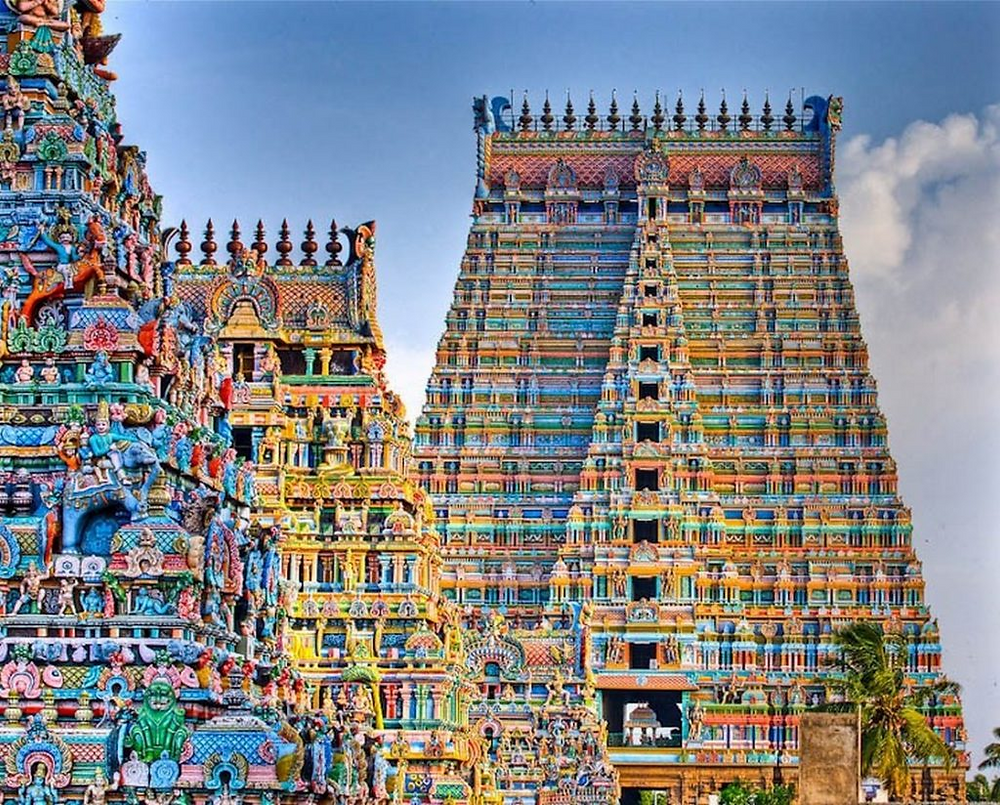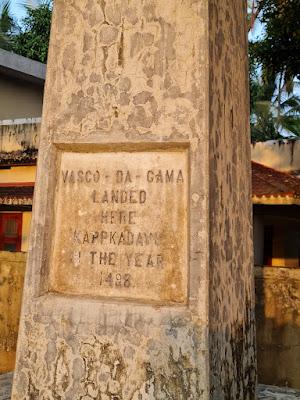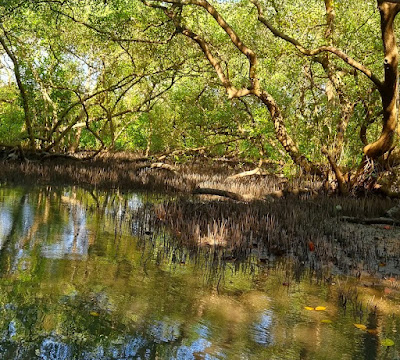"The forests hold answers to questions we have yet to ask."
In the fairytale jungles of Nelliyampathy, there were no witches living in chocolate and wafer cottages, nor were there elves hiding behind trees, waiting to leap out with mischief. And yet, a sense of magic hung in the air—subtle, ancient, and endlessly fascinating. These evergreen forests in the Palakkad district of Kerala seemed to hum with untold stories, revealing their enchantment not through fantasy, but through the quiet, awe-inspiring presence of nature itself.
We arrived in Nelliyampathy after dusk, welcomed by the soft glow of a Phalgun moon casting silver light over the rolling hills. The route felt enchanted, every curve of the winding road shrouded in mystery. It struck me then—I hadn’t experienced a forest at night in a long time. Certainly not one as lush, as wild, and as full of life as this.
As if to welcome us, a sambhar deer trotted calmly across the highway, unbothered by the beam of our headlights. From the darkened canopy, the calls of owls echoed—joined by the rustlings of other nocturnal creatures waking to their own world. It was hauntingly beautiful.
To my surprise, our accommodation turned out to be nestled right next to a tea factory, surrounded on all sides by gently sloping tea gardens. Even though it was late, the excitement of being in such a stunning setting made it impossible to stay indoors. My bestie and I dropped our bags, put on our shoes, and stepped out for a moonlit walk. The air was cool and smelled of damp earth and tea leaves. We agreed, as we have on other such soul-stirring journeys, that some experiences are worth going out of your way for.
For us, this trip had one special purpose: to catch a glimpse of the majestic Great Indian Hornbill, the state bird of Kerala. Watching it in its natural habitat had long featured on our dream list. And now, here we were—in the land of misty hills and murmuring forests—ready for a magical encounter we’d long been waiting for.
The next morning, by six o'clock, the light had not yet fully arrived. The hills were still cloaked in mist, their silence broken only by the soft rustle of leaves and distant birdcalls. We began our quiet chase for the magnificent Great Indian Hornbill, hearts full of anticipation and eyes scanning the treetops.
We were fortunate—accompanied by an expert wildlife photographer who not only shared our enthusiasm but also knew exactly where to look. Thanks to him, we soon found ourselves parked along the edge of a tea estate, staring up at a tall, solitary tree with a cavity in its trunk. That hollow, barely noticeable to the untrained eye, was a hornbill nest.
Inside, the female hornbill had sealed herself in with a mud wall, leaving only a narrow slit through which the male would pass food. She would remain inside for weeks, incubating the eggs and caring for the chicks, dependent entirely on her partner’s regular offerings of wild fruits. This ritual of self-imprisonment—a marvel of nature’s design—was as awe-inspiring to witness as it had been when I first read about it.
We waited quietly, our breaths held and cameras ready, watching that opening in the tree with reverence. The forest around us slowly came alive with the soft light of dawn, and I found myself moved—not just by the sight, but by the devotion and delicate balance of trust this moment revealed.
The hole in the tree trunk was barely wide enough for the two curved beaks to meet—just sufficient for the careful exchange of fruits and other food items. A small passage for an act of deep devotion.
Though the calendar still read Phagun, the temperature had begun to rise, edging past the comfort of spring into the hints of an early summer. But in the cool shade beneath the dense canopy, it felt like time had slowed. The breeze drifting through the trees carried with it the soft, melodic calls of hill mynas, weaving a kind of forest lullaby that made us forget the world beyond the jungle.
For a while, the forest was quiet, save for a troupe of Nilgiri langoors leaping gracefully between trees and the sight of green avocados dangling in clusters like ornaments. Then, breaking the calm, we heard it—the unmistakable, heavy flapping of wings. And there it was.
A huge male Great Indian Hornbill glided in and perched on a tree across from the nest. Majestic and alert, he paused for a moment, scanning the surroundings for any sign of danger. Satisfied, he took flight again and landed near the narrow slit in the tree trunk. The feeding began—a delicate, practiced exchange that felt almost sacred.
As if guided by clockwork, the male returned every two hours with food for his mate and their chicks—an unbroken rhythm of care and constancy. We watched, mesmerized by the dedication and precision of this partnership.
Still in a daze from the incredible beauty of what we had just witnessed, we made our way to another nesting site. Here, the female had recently broken free of her weeks-long confinement. Stepping into the sunlight just a few hours earlier, she had emerged into a world changed—and waiting.
What greeted us was perhaps the most endearing sight of birds I have ever seen. The male hornbill stood nearby, gazing toward the nest with unmistakable anticipation. In his beak, he held a freshly hunted snake—a gift for his mate, a celebration of reunion. There was tenderness in his posture, and something almost human in the way he waited.
Moments like these leave a quiet imprint on the soul. In the heart of the forest, far from the noise of daily life, we were offered a glimpse into a world built on instinct, care, and silent loyalty.
The scene unfolding before us felt no less dramatic than a well-scripted television soap—except it was real, raw, and utterly moving.
The female hornbill finally emerged, her feathers ruffled, her body visibly drained from weeks of confinement. Her flight was laboured, and she struggled to gain height. She managed to perch on a nearby tree, where the first thing she did was begin sharpening her beak—a small but necessary ritual after her long isolation.
I stood there, watching in silence, filled with awe and a touch of ache. I had read that these magnificent birds are monogamous, choosing one partner for life. Their bond is not just emotional—it’s one of survival. If the male fails to return with food during the nesting period, the female will perish inside her sealed nest, along with the unborn or newly hatched chicks. There are no second chances in this delicate balance of nature.
And yet, here they were—reunited in the forest light, after a long separation marked by trust and unwavering faith. It was one of the most profound expressions of devotion I’ve ever witnessed in the wild. A love story played out not in words, but in instinct, endurance, and silent promises.
Though we were still spellbound by the hornbills and their intimate family drama, our attention was soon stolen by another spectacle of the forest. A noisy commotion had broken out a little further along the trail—a group of lion-tailed macaques had discovered a jackfruit-laden tree and were descending on it with unbridled enthusiasm.
Clad in sleek black fur with striking silver-gray manes framing their faces like wild crowns, these charismatic primates moved with surprising agility. Their expressive eyes and almost regal presence made them impossible to ignore. Watching them tear into the ripe jackfruits with gusto—chattering, jumping, squabbling—felt like stumbling upon an impromptu forest feast.
Our guide, with quiet excitement, explained just how rare this sighting was. Lion-tailed macaques, he said, are elusive and notoriously shy of human presence. They are among the most endangered primates in the world, found only in the Western Ghats of South India. To see a group like this, out in the open and so energetically engaged, was a gift.
He went on to tell us about the Save Silent Valley movement—a defining moment in India’s environmental history. Between 1977 and 1980, public concern over the rapidly vanishing habitat of the lion-tailed macaque galvanized one of the fiercest environmental campaigns the country had seen. The movement ultimately led to the protection of the Silent Valley forest in Kerala, a decision that still echoes as a milestone in India’s conservation efforts.
It struck me then—how much of what we were witnessing was not just nature, but history and survival braided together. These creatures were not merely part of the forest; they were living symbols of resistance and resilience.
Despite our eyes being fixed on the romantic hornbill couple, we couldn’t help but be drawn to the other equally captivating glimpses of jungle life—a hanging ant nest swaying gently in the breeze, the flickering movement of birds darting through branches, flashes of blue, green, and russet against the morning light. Every corner of the forest seemed alive with subtle wonders, each telling its own quiet story.
Not wanting to disturb the hornbills any further, we decided to move on—venturing deeper into the jungle. The road gradually faded into a wild trail, then disappeared altogether, swallowed by the thick undergrowth. Here, the jungle reigned in all its untamed glory. It was raw, unapologetic, and astonishingly beautiful.
With no mobile signal for miles, we were cut off from the world beyond—though we didn’t mind. The silence, when not broken by our own footsteps, was filled with a natural orchestra: the steady hum of crickets, the occasional scream of a peacock echoing across the valley, the rustling of leaves stirred by hidden movement. It was a symphony that required no conductor, only attentive ears.
What struck me most was the reminder that it isn’t just the charismatic megafauna—the hornbills, monkeys, elephants, or tigers—that make up the rich tapestry of the jungle’s lore. It’s also the small, easily overlooked lives—the electric blue frogs camouflaged against mossy stones, the intricate webs of giant wood spiders glistening between trees, the humble ants building their homes in mid-air. Every creature, big or small, is a vital thread in this living, breathing ecosystem.
The forest doesn’t perform for you. It simply is—unfolding its drama in layers, offering glimpses only to those patient and quiet enough to observe.
Perhaps one of the most delightful sights of all was the Giant Malabar Squirrel—its deep maroon and rust-colored coat catching the dappled light as it leapt effortlessly from tree to tree. With its bushy tail and surprisingly agile movements, it looked like a playful spirit of the forest, reminding us that beauty often comes in quiet, unexpected forms.
But the jungle still had one last gift in store for us.
As we continued our journey deeper into the woods, we stumbled upon a breathtaking sight—an unexpected, almost surreal migration of Dark Blue Tiger butterflies. Hundreds of them fluttered across our path in a graceful, hypnotic wave, their velvety black wings streaked with pale blue seeming to shimmer against the green backdrop. It felt like walking through a living painting, where the air itself had turned into something magical.
We stood still, not wanting to break the spell. The butterflies danced around us for a few fleeting moments before disappearing into the trees, leaving behind a sense of wonder we couldn’t quite put into words.
I have certainly never seen so many butterflies together in my life. They fluttered around us in such numbers that it felt like the forest itself had come alive in celebration. And honestly, if someone had whispered to me in that moment that they were fairies in disguise, part of some secret woodland fairytale, I would have believed it without hesitation. That’s how magical it felt.
Jungles have an aroma of their own—a complex blend of dead leaves, damp moss, decaying wood, and the faint trace of life lost and reborn. It’s an earthy, ancient scent that clings to the air and seeps into your senses. But this forest was different. It was fragrant beyond imagination—with the unexpected sweetness of coffee blossoms.
I’ve seen coffee plants and plantations before, but never like this. Somehow, I had never noticed—never known—that coffee flowers could be so exquisite, so intoxicatingly fragrant. The smell was heady and floral, reminiscent of lime blossoms with a delicate citrusy note. It lingered in the breeze, soft and persistent, turning every breath into a quiet delight.
We walked through the scented forest in awe, inhaling deeply, savoring the moment. Even the air felt more alive, charged with an energy that was both calming and uplifting. It was one more reminder that the jungle holds endless surprises—some hidden in plain sight, waiting patiently to be noticed.
After driving some 16 kilometers into the forest—past serene lakes alive with the flutter and chatter of tiny birds—we finally reached a watchtower perched quietly on a high point, overlooking the vast stretch of the hill ranges. It felt like the forest had brought us to its very heart.
It was a full moon night, and though daylight had not completely faded, the moon had already risen, casting a silvery glow over the landscape. It wasn’t just rising—it was smiling, luminous and unhurried, bathing the treetops in soft light and reflecting off the still waters below.
We stood there in silence, soaking in the view—part sky, part earth, entirely wonder. The breeze was cool, the air fragrant with distant blossoms, and the forest below shimmered with life. It felt like a perfect pause, the kind you don’t want to end.
The next morning, the sky opened with a breathtaking palette of colors. As the sun rose, the valley was bathed in soft hues of pink and orange, gently spilling over the misty mountains that glistened as far as the eye could see. It was the kind of sunrise that made you instinctively quiet, just to absorb its majesty.
The forest stirred awake with its own music—crickets still humming from the night, peacocks calling in the distance, and monkeys chattering as they welcomed the light. The lakes, already alive at dawn, were buzzing with birds darting over the surface and calling from hidden perches.
The stillness of the tea and coffee plantations was broken by the cheerful movements of bulbuls hopping from branch to branch, their presence as joyful as their songs. Within the next hour, the forest offered up a cascade of delights: a colony of blue-black frogs gathered by the lakeside, groups of dollarbirds flashing turquoise in the sun, a pair of Malabar Grey Hornbills perched silently as if keeping watch. Spotted deer grazed nearby, their calmness adding to the gentle rhythm of the morning.
Time, by then, had completely slipped away.
And somewhere in the distance, we heard the unmistakable call of elephants—deep, slow, powerful. We couldn’t see them, but we didn’t need to. Just knowing they were there, part of this great interconnected world, was enough.
In many world cultures, people have long recognized the value of being immersed in the forest. The Japanese practice of Shinrin-yoku, or forest bathing, is now widely acknowledged for its calming, restorative effects—something even modern therapists and healers have come to embrace. But as I stood there, watching dappled sunlight filter through the high canopy, the realization that struck me was more rooted in our own ancient tradition: the wisdom of vanaprastha—the idea of retreating to the forest at a certain stage in life.
In that moment, it made perfect sense. To step away from the noise, the rush, the endless demands of the world—to go back to the forest, not just to rest, but to remember. To relearn the basics: silence, patience, stillness, humility. The forest doesn’t just offer escape; it offers clarity. A quiet mirror in which you can see yourself, and your place in the world, a little more clearly.




































